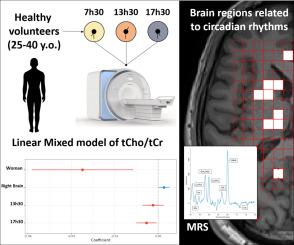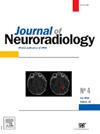Time-of-day study on brain metabolism using proton magnetic resonance spectroscopy
IF 3.3
3区 医学
Q2 CLINICAL NEUROLOGY
引用次数: 0
Abstract
Most human physiological processes follow circadian rhythms such as glucose metabolism and neuronal activity, thereby playing a major role in brain metabolism regulation. Proton Magnetic Resonance Spectroscopy (1H-MRS) has become a valuable tool for quantification of brain metabolism in clinical settings. Nonetheless, only limited evidence of brain metabolism variation throughout the day has been found, restricted to specific brain regions or limited by a sample size. The aim of this study was to investigate time-of-day effect on brain metabolism in 1H-MRS of different brain regions associated with circadian rhythms in healthy adults.
This prospective monocentric study included 39 healthy volunteers aged between 25 and 40 years. They underwent three 3T MRI examinations the same day at 7:30, 13:30 and 17:30. Two CSI MRS sequences were acquired to study brain regions of the basal ganglia and semi-oval center. A linear mixed model was used to investigate differences between session times, sex and brain hemisphere on acquired total Choline (tCho), total N-Acetyl-Aspartate (tNAA), and Lactate (Lac).
Models showed a significant decrease in tCho/tNAA in the last session of -1.60% (p = 0.017) and a lower value of tCho/tCr of -9.74% (p = 0.014) and tCho/tNAA of -7.98% (p = 0.044) for women as compared with men. In the right hemisphere a higher value of tNAA/tCr of +2.84% (p < 0.001) was found, while tCho/tNAA was lower by -1.60% (p = 0.003) compared to the left hemisphere.
The metabolite ratios under investigation were not affected by circadian rhythms, except for a small decrease of tCho/tNAA at 17:30. However, sex and brain hemispheres had a significant impact on brain metabolism. While brain MRS examination for most common metabolites could be carried out at any time of day, it is still important to consider the patient’s sex and the side of the brain being examined.

利用质子磁共振波谱技术研究脑代谢。
人类大多数生理过程都遵循昼夜节律,如葡萄糖代谢和神经元活动,因此在脑代谢调节中起着重要作用。质子磁共振波谱(1H-MRS)已成为临床定量脑代谢的一种有价值的工具。尽管如此,只有有限的证据表明全天大脑代谢的变化,仅限于特定的大脑区域或受样本量的限制。本研究的目的是研究时间对健康成人与昼夜节律相关的不同脑区1H-MRS脑代谢的影响。这项前瞻性单中心研究包括39名年龄在25至40岁之间的健康志愿者。当天分别于7:30、13:30和17:30进行了3次3T MRI检查。获得两组CSI MRS序列,对基底节区和半卵圆中心区进行研究。采用线性混合模型研究了获得性总胆碱(tCho)、总n -乙酰-天冬氨酸(tNAA)和乳酸(Lac)在训练时间、性别和脑半球之间的差异。模型显示,与男性相比,女性的tCho/tNAA在最后一段时间显著下降-1.60% (p = 0.017),tCho/tCr为-9.74% (p = 0.014),tCho/tNAA为-7.98% (p = 0.044)。右半球tNAA/tCr值较高,为+2.84% (p < 0.001),而tCho/tNAA值较左半球低-1.60% (p = 0.003)。所研究的代谢物比率不受昼夜节律的影响,除了17:30时tCho/tNAA略有下降。然而,性别和大脑半球对大脑代谢有显著影响。虽然对大多数常见代谢物的脑磁共振检查可以在一天中的任何时间进行,但考虑患者的性别和被检查的大脑一侧仍然很重要。
本文章由计算机程序翻译,如有差异,请以英文原文为准。
求助全文
约1分钟内获得全文
求助全文
来源期刊

Journal of Neuroradiology
医学-核医学
CiteScore
6.10
自引率
5.70%
发文量
142
审稿时长
6-12 weeks
期刊介绍:
The Journal of Neuroradiology is a peer-reviewed journal, publishing worldwide clinical and basic research in the field of diagnostic and Interventional neuroradiology, translational and molecular neuroimaging, and artificial intelligence in neuroradiology.
The Journal of Neuroradiology considers for publication articles, reviews, technical notes and letters to the editors (correspondence section), provided that the methodology and scientific content are of high quality, and that the results will have substantial clinical impact and/or physiological importance.
 求助内容:
求助内容: 应助结果提醒方式:
应助结果提醒方式:


